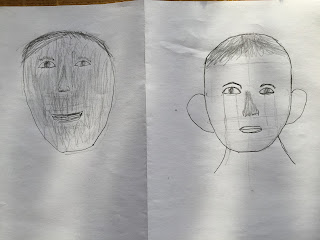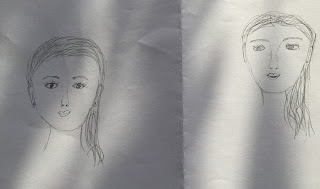That's what was written on the board as a provocation starter.
What do we think this means?
- We can measure the lengths of features on our face.
- We could measure its area.
- We can compare the sizes of things on our faces.
- We could count the number of hairs on them.
Some nice ideas to warm up our minds.
To begin, we drew a 3 minute sketch of our partner's face:


In visual arts, we been exploring drawing techniques and in particular learning to draw with our eyes instead of our hands. We have been exploring how we should try to look at the object more than the paper, but when it comes to drawing a human face that seemed more challenging to do than other drawing experiences we've been doing.
Still, this served the purpose well.
What is the shape of the human head?
- ovally
Is it wider at the top of the bottom?
- hmmmmm
Look at your partner's head.
- It's wider at the top.
Exactly.
So we draw a more realistic human head shape.
The human face is made up of fractions, ratios and proportions.
Look at your partner's head. From the top of the skull to the chin where are the eyes placed?
- a third
- a half
- nearly a half
The eyes are half way.
So we sketched a line dividing the head in half and drew the eyes there.
We continued doing this with the nose, then mouth. Each time looking at our partner to determine the fraction or proportion.
As we continued, we discovered by looking at our partner's head each time and then sharing these other fraction /proportion relationships:
° You can fit 5 eyes across the face. So to draw the eyes in the correct place, we divide the space into fifths and then draw the eyes in the 2/5 and 4/5 place.
° To draw where the mouth ends, we draw an imaginary line a third of the inner eye. That's where the mouth ends.
° the mouth is half way between the nose ending and the chin ending
° the neck line joins where the end of the eyes are
° the ears begin at the halfway mark and three-quarter mark (where the mouth is)
In determining these, we practised closing one eye as we have discovered previously whilst sketching to help see an object in 2D rather than 3D (more maths!!!).
We also practised holding our thumbs up as a measurement tool for sketching proportions ( MORE MATHS!!!!!)
We practised these new maths discoveries of the human head for about 5-10 minutes.
When to close, we redrew our partner's face. This time with our new mathematical understandings and compared the two drawings.
Most of us felt our second drawing was a much better likeness.
In orally reflecting:
- This year I've been discovering loads about how maths is connected to everything, but even our heads has fractions! That's amazing!
- I'm amazed that we can use ratios and proportions for so many different things.
- I want to be a professional artist when I'm older and now I know even more how maths can help me.
- I wonder if we can find similar fractions and proportions in animal faces?
Before & after mathematical understandings with practise sketchings:

With reflective understandings like that, we know we have had a pretty successful learning experience.
That together with observing the pride in so many of the children at seeing the progress they had made when they compared their before and after sketches!
My next mission- how to help children enquire into the relationship between maths and music........ I need to do some research.






No comments:
Post a Comment
What do you think? ...........